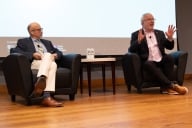You have /5 articles left.
Sign up for a free account or log in.

Just 30 percent of Student Voice survey respondents believe that their professors take affordability into account when selecting course materials.
NosUA/iStock/Getty Images Plus
Affordability is a top concern for students purchasing and interacting with course materials, according to the recent Student Voice survey on academic life. Just 30 percent of the survey’s 3,004 two- and four-year college respondents believe their professors take affordability into account when choosing course materials.
Another quarter of respondents say they believe their professors explicitly do not take affordability into account when choosing materials, with students at private institutions especially like to say this (32 percent, versus 25 percent of students at public institutions). By race, white and Asian students are likelier than Black and Hispanic students to say their professors don’t take affordability into account, at about three in 10 compared to two in 10, respectively.
Lacey Wallace, a research analyst at the National Association of College Stores, says that students have been spending less on course materials over time for a variety of market and other factors, including the rise of digital content. The average per-student materials expenditure is now about $38 per class or $339 per academic year, according to the association’s own data—the lowest figures since the group began tracking them in 1998. Spending on textbooks and other materials also has shrunk as a share of college costs over time.
Even so, Wallace says materials remain “a very visible expense [to students], because you’re pulling out your credit card. It’s not just thrown in your student loan.”
Asked to share a frustrating issue related to course materials that doesn’t get enough attention, Student Voice respondents overwhelmingly cite price. In write-in comments, many students say that books and other materials simply cost too much, or that they’re required to buy texts they don’t end up using. Others argue that course materials should be included in tuition. Professors requiring the latest textbook editions, regardless of whether the books include substantial updates, is another concern, since this makes it harder to find used copies at a reduced price.
“Textbooks and course materials should be included in the cost of the class/tuition and provided for the students if they’re going to be required,” says one student at a private university in Illinois. “Students should not have to pay for a class only to have to spend more money on materials that they didn’t plan for and potentially won’t use for more than a few months (if at all). Some professors make you buy materials and then you never use them, which is a waste of money.”
Numerous students also say they resent having to buy the latest edition of a textbook to obtain a digital key or access code to be able to do included homework online. Relatedly, some students don’t appreciate having to pay for the separate, fee-based homework submission platforms their professors may mandate, some of which cost as little as $30.
Students also describe sourcing or accessibility issues, such as when professors don’t post course materials lists well in advance. But even these kinds of comments tend to link back to affordability. For example, some students say they avoid classes with relatively expensive texts or materials, or that finding out about materials late makes it harder to find used or otherwise reduced-cost versions. Several students say that they risk running out of cash for textbooks if titles are posted late.
“Students should have plenty of time to obtain the books,” says one student at a public university in Pennsylvania. “The university store is expensive, and I am not alone in wishing I had the time to find a cheaper option. I have dropped classes and chosen to pirate materials instead of buying them because I was not given enough time to find a cheaper alternative.”
Michael R. Moore, a research scientist at the University of New Hampshire who studies innovative course material interventions, says the share of faculty members who care about affordability is likely higher than what students perceive it to be. (National Association of College Stores data indicate that faculty awareness of materials costs is growing.) Still, the Student Voice finding that just three in 10 students think their professors care about affordability “goes to the heart” of Moore’s research on materials models such as inclusive access.
“Course materials is the last variable cost in higher education. When you sign up for college, your tuition and fees are all priced out for you, except course materials,” he says.
How Students Source Course Materials (or Don’t)
Half of Student Voice survey respondents say they’ve avoided purchasing or renting a book for a class, with students at private institutions most likely to say this (57 percent, versus 50 percent of students at publics). Perhaps counterintuitively, 56 percent of upper-middle-class students say they’ve avoided buying or renting a book for a class, compared to 46 percent of lower-income students. Continuing-generation students are similarly more likely than first-generation students to say this, at 56 percent versus 46 percent, respectively. And white students are likelier than other racial groups to say they’ve avoided buying or renting a book for a class—as are men relative to women.
Just about a third of students who took all their classes online in fall 2022 (n=352) say they’ve avoided buying or renting a book for class, meanwhile.
Along similar lines, students’ No. 1 preference (among 10 options offered) for obtaining course materials is finding a digital version for free—some 55 percent of students prefer this method. Students who took all their classes online in fall 2022 are much likelier to prefer free digital sourcing than students who took all their classes in person, at 57 percent compared to 33 percent, respectively. Students at private institutions also are likelier to say this than are students at public institutions (62 percent versus 53 percent).
Various other options for renting and buying are preferred by about the same percentage of students—from finding a used copy on Amazon or in the campus store to renting a digital or physical copy. Students are least likely to want to buy a new copy, physical or digital, from the campus store. (According to the National Association of College Stores, students still actually purchase 55 percent of their materials from campus stores, along with 45 percent of rentals.)
About a quarter of students say they’ve taken photos of pages or chapters from someone else’s book for a class, with this behavior more likely at private institutions than publics (34 percent versus 22 percent, respectively). A quarter of students have borrowed books from friends or classmates.
In general, Moore says student responses “reinforce what we already know: students will avoid paying [for] or acquiring their course materials at all costs, regardless of the detriment to their grades or course performance.” (Moore says he’s particularly interested in what “free” means to students, from open educational resources to piracy. The National Association of College Stores’ annual student survey found that about 11 percent of college students have pirated at least one course material or obtained materials through unauthorized means, usually in a PDF format.)
One in 10 students has printed out digital books after renting or buying them for a class, with this option being more common among students 24 or older, according to the Student Voice survey. Students with learning disabilities or related conditions (n=649) are not more likely than those without to print out digital books.
Half of students say they’ve kept a book once a class is over, and about 28 percent say they’ve sold or donated books.
About one in 10 students has thrown out a book after a class.
Freshness and Diversity in Course Materials
The Student Voice survey also asked students if their professors choose generally up-to-date, diverse and interesting course materials.
Two-thirds of students say their professors choose up-to-date materials, with students who took all their classes in person in fall 2022 likelier to say this than students who took all classes online. Relatively more students at private institutions say their professors choose up-to-date materials, as well, at about three in four students compared to two in three students at public institutions. Again, students have mixed thoughts on newness of materials, with some preferring older editions that are easier to find at a reduced cost, unless the content has been substantially updated. Just 18 percent of students say their professors choose outdated materials.
Fewer than half of students (42 percent) say their professors choose diverse instructional materials representing a variety of perspectives and voices. Results are relatively consistent across racial and gender groups and among straight and LGBTQIA+ students. Students who identify as strong Democrats are slightly more likely to say materials are diverse than are students who identify as strong Republicans, with possible implications for what’s been referred to a viewpoint diversity in course materials. Just 10 percent of students say their professors choose homogenous materials.
A third of students say that their professors choose interesting course materials, with differences by race: 39 percent of white students and 32 percent of Hispanic students say their professors choose interesting materials, compared to 26 percent of Asian students and 22 percent of Black students. By discipline, social sciences and arts and humanities students are likelier to deem their materials interesting than are students in the natural sciences. Relatively more students at private institutions than publics say their course materials are interesting, as well (40 percent versus 33 percent, respectively). A quarter of students say their professors choose boring materials.
Closing the Digital Divide?
As for which type of course materials students prefer, half say a mix of digital and physical materials. Just over three in 10 say digital materials, and fewer than two in 10 prefer physical materials. The breakdown is about the same for two-year and four-year college students, with physical materials being slightly more popular at private institutions. Students who took all their classes online in fall 2022 are significantly more likely to prefer digital materials than are students who took all their fall 2022 classes in person (54 percent versus 27 percent). First-year students (those with an anticipated graduation in 2027) are likeliest of all year groups to prefer a mix of digital and physical materials, at two in three.
Looking at socioeconomic status, working-class students are least likely to want all-digital materials (25 percent), and upper-class students are most likely to prefer them (37 percent). Students with full-time jobs also are likelier than the group over all to prefer all-digital materials, at 39 percent.
Moore, of the University of New Hampshire, says that the 17 percent print-only response “does give us an indication that digital is more widely accepted than just a few years ago.” It’s also “encouraging” that students taking online classes prefer digital over a print format, especially as online programs are expanding.
Robert Jansen, director of retail operations at the Three Rivers College store in Missouri—who spearheaded an equitable access program in which students get automatic access to physical and digital materials for a fee—says that students care most about “accessibility and affordability.” New access models help on this front, he says, in that it’s no longer the “Wild West” in terms of sourcing and paying for materials.
Student success advocates also point to greater course completion rates at institutions with innovative access models, Jansen adds, noting research by Moore that found a 16 percent increase in course completions for equitable access program participants in the two-year college setting. “The more you can do to reduce these barriers to or reduce these life events that will take people out [of college], the better.”
Read more about the Student Voice survey here.









